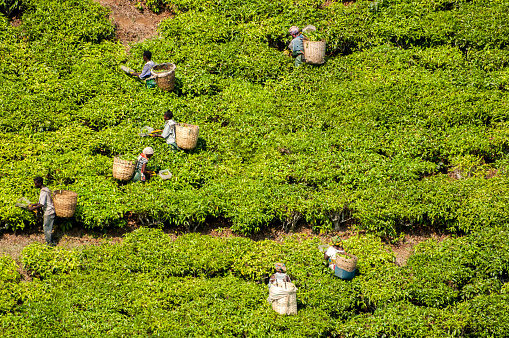
When you reach for the shelf, you may see that products have an ever-growing amount of labels and certifications, generally designed so that you have a better idea of what’s going into your purchases. Among the mix are several fair trade certifications—but it can be a bit confusing as to what they mean. Learn what fair trade is, why it’s so important and where you can work fair trade items into your daily routine.
What Is Fair Trade?
The exact mechanisms by which fair trade is implemented can vary wildly, so let’s start with the intended purpose. According to Fairtrade International, fair trade is an alternative approach to conventional trade and is based on a partnership between producers and consumers. Farmers and producers around the world, particularly in developing countries, who have the opportunity to sell their goods under the terms of fair trade ultimately get better deals and more control over the trading process, giving them both fair wages as well as the means to better their communities and take a stronger part in the global marketplace (1). The amount of goods with fair trade options are rapidly expanding, spanning from food items like coffee, cocoa, produce and herbs to personal care items to even clothing and furniture.
Why Use Fair Trade?
In 2013, global fair trade sales reached a total of over 4.4 billon pounds 15% rise from the year before with the United Kingdom as the biggest buyer (2). It’s clear that fair trade has already become a hot buzzword that people are looking for, but if you’re still on the fence about buying fair trade, there are a number of things to consider.
Quality. It’s safe to say that you look for the highest quality and safest product available, particularly in the case of food. By buying fair trade items, you are often buying products sourced from small farms, with crops grown in smaller quantities. Many fair trade, organizations are often involved with other environmental measures designed to ensure the highest quality possible. In addition, information from Fair Trade USA says that many of its farmers have used some of their added funds, earned through fair trade, to go through organic certification—as a result, nearly half of their Fair Trade Certified imports are also organic (3). Genetic engineering is also banned in fair trade products.
Environment. Many of the same measures that keep fair trade products high quality also protect the environment and conserve valuable natural resources. Perhaps the best example of this are the sustainable farming practices that go hand in hand with fair trade farmers, like proper management of water and soil, discouragement of practices like slash-and-burn farming and minimal use of chemicals and pesticides. Supporting fair trade is a way to support these kinds of actions right at the register.
Support. It can be difficult to put a face to a product sometimes, especially when it’s made in a foreign facility then goes through many channels before it gets to you. With fair trade, you get the opportunity to do just that. In the case of clothing, jewelry and furniture makers, you get to help artisans from another culture support themselves and their community, knowing that their products are being sold, or are selling and also that they are making proper wages off of them. This leads into one of the biggest positives of fair trade:
Transparency. The natural products industry is very forward thinking when it comes to corporate responsibility, but unfortunately, not all companies heed to these principles. Unsafe work environments, low wages and poor business practices are a reality, and many of the workers who have to deal with these conditions often have minimal options when it comes to making a living. Buying fair trade ensures that your purchases go toward a more thoughtful path—an exchange where everyone involved at each step of the supply chain gets benefits, rather than being lopsided to one side or the other.
In some cases, the presence of fair trade may steer public opinion regarding labor practices with larger companies as well. In 2012, a major chocolate manufacturer was the subject of legal action accusing it of being aware of child labor present in its supply chain. Much of this labor took place in the Ivory Coast, where 40% of the world’s cocoa is sourced. The discovery caused a wave of public opinion demanding a switch to fair trade, and the manufacturer ended up pledging to make the full switch by 2020. With examples like these, some of your favorite mainstream companies may be eyeing fair trade options as well.
Where Can I Get Fair Trade?
Unlike the cases of USDA Organic Certification or Non-GMO Project Verification, there’s not necessarily one standard banner to look to when it comes to fair trade. Since it can be rather difficult to make a choice, here are some popular certifications you are likely to see.
Fairtrade International, (www.fairtrade.net) is the overall largest global fair-trade organization, with its FAIRTRADE Mark found on over 27,000 products worldwide. Its U.S. arm, Fairtrade America (www.fairtradeamerica.org), was launched in 2011. Other entities like Fair Trade Federation (www.fairtradefederation.org) and Fair Trade USA (www.fairtradeusa.org) also have a strong presence on store shelves. Whichever fair trade label you see, be sure to learn more about the organization it’s associated with to make sure your purchases are supporting the people and causes you want them to. WF
References
1. Fairtrade International, “Aims of Fairtrade Standards,” www.fairtrade.
net/aims-of-fairtrade-standards.html, accessed 8/26/2015.
2. The Guardian, “Global Fairtrade Sales Reach £4.4bn Following 15% Growth During 2013,” www.theguardian.com/global-development/
2014/sep/03/global-fair-trade-sales-reach-4-billion-following-15-per-cent-growth-2013, accessed 8/26/2015.
3. Fair Trade USA, “Frequently Asked Questions,” http://fairtradeusa.
org/what-is-fair-trade/faq, accessed 8/26/2015.
Published in WholeFoods Magazine November 2015










